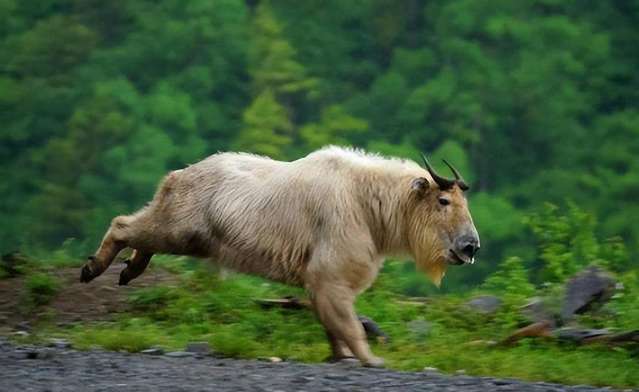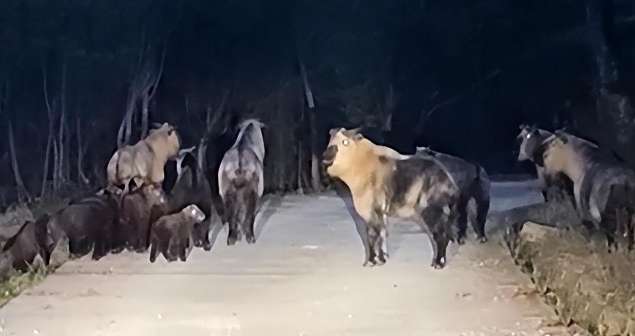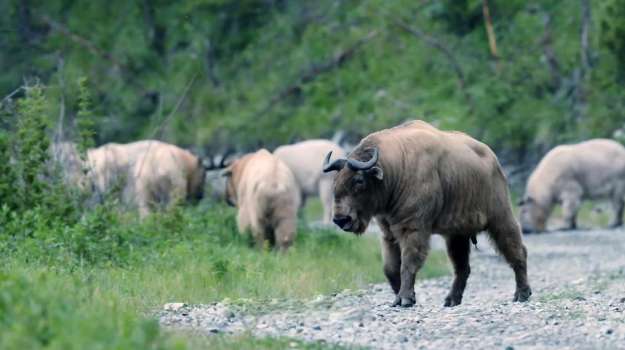In the mythological story "The List of Gods", Jiang Ziya's mount is a mythical beast named "Liu Xiang". do you know? In fact, in real life, there is also an animal that is also called the "six-unlike" because it combines the characteristics of multiple animals. This animal is the takin.
This is a large ungulate animal with a large body and a ferocious personality, belonging to the family Bovidae and the genus Takin. They are large in size, with males weighing up to 400 kilograms when they reach adulthood, and the largest ones can even reach 1 ton.

Takin in the world can be divided into 4 categories The subspecies are: Qinling takin, Sichuan takin, Bhutan takin and Gongshan takin. It happens that these four subspecies are distributed in my country.
Takin are a very rare wild animal. In the past, it was difficult to see them even in deep mountains and old forests. But have you ever felt that in the past ten or twenty years, the number of wild animals around us has obviously increased. Take wild boars as an example. In the past, they were rarely seen in rural mountains and forests, but in recent years, on the streets of major cities, There are also occasional wild boar sightings.
As for wild boars appearing on some mountainous roads, it is more common. Like most wild animals, the takin population is gradually increasing. Recently, staff of the Giant Panda National Park came across a herd of takin while patrolling the Laohegou area in Mianyang, Sichuan.
Takin roam the roads in herds, with the body of an ox and the face of a deer, and look strange
The takin living in the Laohegou area of Mianyang in the Giant Panda National Park belong to the Sichuan subspecies. The characteristics of this subspecies are: The hair on the body is light yellowish gray or straw color, with dark patches on the back, buttocks and legs. Simply put, compared with the Qinling takin, the Sichuan takin has more dark hair on its body, so its appearance looks good. It is not as tall as the Qinling takin.
From the picture, we can see more than 10 takin appearing on the road together. They walk slowly and seem not to be afraid of the vehicles on the road at all. They are still walking slowly.
There are adults, sub-adults, and juveniles in the group. Obviously this is a healthy takin population with a good age structure.
From the appearance, this group of takin looks very strange. They are said to be cattle, but they have the characteristics of sheep, and they also combine some characteristics of other animals.
To be precise, a takin has a face like a moose, horns like a wildebeest, a ridge on the back like a brown bear, thick limbs like a cow, short hind legs like a hyena, and a broad and flat tail like a goat.This takin is also known as the "six different animals".

The coat colors of takin living in different regions also vary. However, there is a general pattern, that is, the further north the habitat is, the lighter the hair is. The hair on older individuals will become more and more golden, shining golden under the sunlight, which is very beautiful.
Group actions are disciplined, and there are no natural enemies under the tiger
Takin are very intelligent animals. They live in groups in multiple camps, and the groups they form are often very large. For example, before In Tangjiahe, people observed a group of hundreds of takin.
The takin that move in groups are very disciplined. When they are eating, there will be a strong male member who stands high and looks around, taking on the responsibility of sentry. Once danger signals are detected, the herd will be alerted immediately and prepared to respond.
When the herd of takin moves forward, the strong adult bulls will walk at the front and back of the team, playing the role of leading and holding back the group. The female takin and some calves will walk in the middle of the team and are well protected.
Over the years, the number of takin has increased visibly to the naked eye. In addition to the improvement of the ecology and the gradual deepening of animal protection awareness, a large part of the reason is that the South China tiger has disappeared in the wild. Takin lack natural enemies that can effectively inhibit the development of their population, so their numbers continue to increase.
Takin are large and strong. In the natural environment, they really have no natural enemies except tigers. Although leopards have taken over part of the ecological niche of tigers, their ability to suppress such large and ferocious ungulates is still limited. Still very limited.
In addition, takin are also very brave. When encountering an enemy attack, they will charge towards each other collectively under the leadership of the leading takin, making them unstoppable.
With ferocious temperaments and violent tempers, lone male animals are more dangerous
In our impression, most herbivores are relatively docile, but this is not the case with takin. It has a ferocious personality and a hot temper, even worse than some carnivores.

Especially during the estrus period, fierce conflicts often break out between male takin in order to compete for mates. In order to gain an advantage in the battle, takin often use tree trunks to polish Their own horns make them smooth and sharp.
Takin are also extremely dangerous to humans, especially the lone male takin, which is the one that hurts the most people. According to the 2008 " Chengdu Commercial Daily reported that in the past ten years, takin have killed more than 20 people and injured more than 150 people.
Originally, tigers lived in most areas of our country. , especially the South China tiger, has a very wide distribution range.
Tiger has a very good inhibitory effect on various large animals in the forest. However, after the 1950s, due to various reasons, the South China tiger It quickly disappeared in the forest, eventually leading to extinction in the wild. The number of other tiger species living in our country, such as the Siberian tiger, Bengal tiger, and Indochinese tiger, also decreased sharply. The final outcome was that the takin already lacked natural enemies.
In the past few decades, the number of takin has increased rapidly, and the probability of people encountering them in the wild has become relatively high. Therefore, you must be careful when entering areas where takin are infested, and especially remember: the ratio of a lone male to a takin is Herds of takin are more dangerous.
Takin are a typical alpine species. They like to inhabit alpine forests and meadows above 2,500 meters above sea level. In winter, they will go to rocky areas below 2,500 meters. They live in the zone.
Although they look cumbersome due to their large size, takin are actually very capable of moving. Even on steep cliffs, they can still walk on flat ground. Sometimes they just want to lick Take a lick of rock salt and you may even climb a cliff.